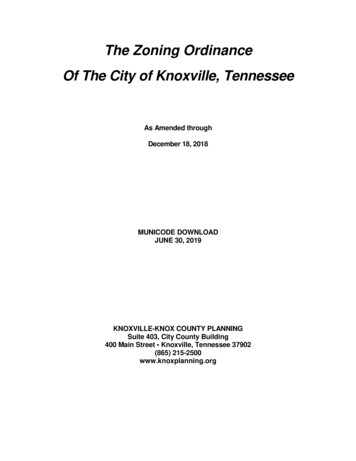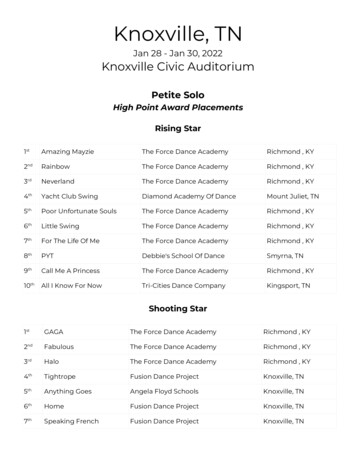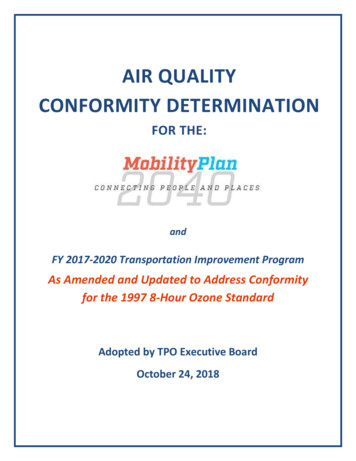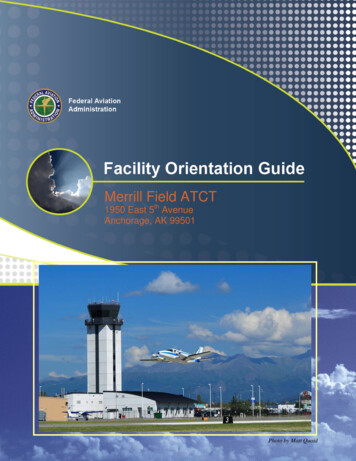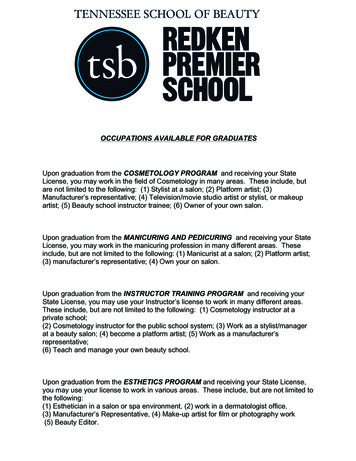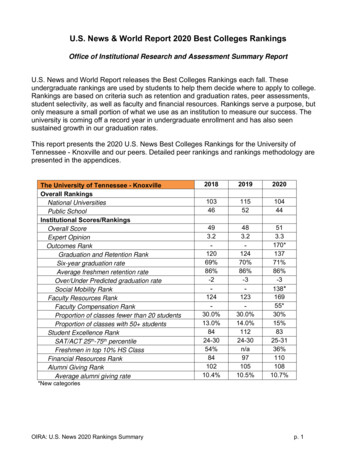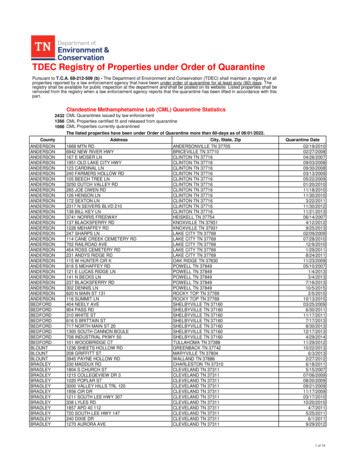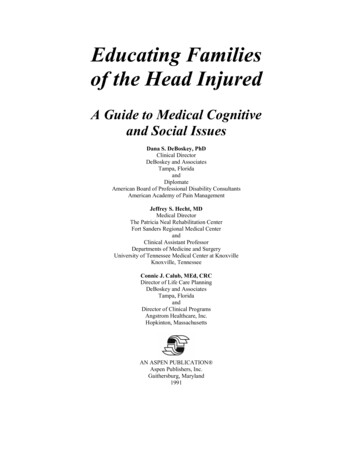
Transcription
KNOXVILLE (TYS) ATCT
TABLE OF CONTENTSWelcome LetterKnoxville Tower TodayKnoxville Tower Leadership TeamOur Expectations of All EmployeesPoliciesLocal Area InformationSporting and Special EventsRestaurants of NoteOnline ResourcesKnoxville Tower and Airport Area MapKnoxville Tower Directory347891215161618212
Welcome LetterDear New Employee,Welcome to Knoxville Air Traffic Control Tower! Here you will have anopportunity to work with an outstanding team of professionals that help makeTYS a great place to work and develop your skills. Your knowledge, abilitiesand positive attitude made you a highly regarded addition to our team, and Iam certain that you will make a positive impact on our future.All of us want to make your tenure at this facility as enjoyable and rewardingas possible. Please feel free to ask any questions and express your thoughtsand ideas to the staff and management. Our aim is to create an informalatmosphere and involve everyone in the process of making our facility anexceptional place to work.I look forward to working with you, and would like to welcome you again to ourteam!Sincerely,Tamera L. EasterdayKnoxville Tower/TRACON Manager3
Knoxville Tower TodayKnoxville (TYS) ATCT is a Level 8 combined Tower and TRACON thatprovides radar services using an ASR-9 Radar and ARTS IIE AutomatedRadar Tracking System. Knoxville Tower provides air traffic services withinan approximately 35 mile radius of Knoxville's McGhee Tyson Airport ataltitudes of 10,000 feet and below.Knoxville Tower began operating in its present location in September, 1987.At 80 feet in height, the tower is nearly twice as tall as its predecessor whichwas located on top of the old passenger terminal building. The tower handlesa mixture of cargo, military and civil flights and has averaged approximately165,000 services annually over the last 15 years. There are currently 38 AirTraffic employees assigned to Knoxville Tower and 15 employees assigned tothe Technical Operations System Service Center--the group responsible formaintenance of navigation aids, radar, communications, FAA buildings andnumerous other pieces of equipment.Although McGhee Tyson is the municipal airport for the City of Knoxville,Tennessee, the airport is actually located partly in the city of Alcoa,Tennessee and the community of Louisville, Tennessee. McGhee TysonAirport was named after Lt. Charles McGhee Tyson, a naval aviator fromKnoxville, who died in an aircraft accident in the North Sea near the end ofWorld War I. His parents donated land to be used as Knoxville's originalairport with the agreement that the airport be named after their son.Knoxville serves as the gateway to the Great Smoky Mountains National Parkand is the home to the University of Tennessee's main campus. Manyindustrial manufacturers such as the Aluminum Company of America, SeaRay Boats, Clayton Homes, Denso, and DeRoyal Industries are located in thearea.McGhee Tyson Airport has two parallel runways, both measuring 9,000 feet,and covers approximately 2,000 acres. The facility is managed by the MKAA(Metropolitan Knoxville Airport Authority), a non-profit organization founded inthe late 1970s.4
McGhee Tyson Air National Guard Base, located on the airport, is home to anumber of military units including the 134th Air Refueling Wing operating theKC-135R aircraft, 119th Command and Control Squadron, 228th CombatCommunications Squadron of the Tennessee Air National Guard. TheTennessee Army National Guard's 278th Air Cavalry Regiment operates theOH-58 Kiowa from the Army Aviation Support Facility #2 on McGhee TysonAirport. Finally, the Air National Guard Training and Education Center, whichprovides professional military training for the entire Air National Guard islocated on McGhee Tyson Air National Guard Base.Commercial carriers serving McGhee Tyson Airport include Allegiant,American, Continental, Delta, Northwest, United and USAir airlines. McGheeTyson Airport serves approximately 1.75 million passengers each year.McGhee Tyson Airport also has an air cargo terminal which is used byFederal Express and United Parcel Service. Over 97 million pounds of freightpassed through McGhee Tyson Airport in 2008.5
Knoxville Tower Organizational ChartAir Traffic ManagerTamera L. EasterdayFront Line ManagersAdministrative StaffMark S. MustardGeoffrey A. WrightFred RenaultQA/Automation: Randy RogersTraining: Vince ContessaSecretary: Suellen RhyneControllersTeam 1Team 2Team 3Team 4Team 5Team 6Team 76
Knoxville Tower Air Traffic ManagerTamera EasterdayAir Traffic ManagerKnoxville Tower (TYS)Tamera joined the FAA in 1981 as an airtraffic controller in Miami, Florida (ZMA).Also while serving in Miami, she was the CoOperative Education Coordinator andprovided oversight to 54 College Co-Opsdoing a work-study program with the FAA.After leaving Miami, she served as acontroller at TRI-Cities Tower (TRI), a Quality Assurance/Training Specialistat TYS ATCT, a supervisor at Chattanooga (CHA), and the Support Managerat Louisville, (SDF). Additionally, she served as an Evaluation Specialist forHeadquarters and also as a Safety Risk Management (SRM) specialist forHeadquarters, before returning to her hometown of Knoxville to serve as thecurrent Air Traffic Manager.Tamera spends her spare time traveling and hiking and enjoying the outdoorsat her cabin in the TN. Mountains.7
Our Expectations of All EmployeesKnoxville Tower's leadership team expects all employees to:1. Come to work, be on time2. Be prepared – mentally and physically3. Understand leave policy and manage your leaveappropriately4. Be cooperative and professional5. Treat people with respect and dignity6. Take initiative7. Be accountable8. Lead by example – be a good role model9. Do not tolerate or engage in any form of harassment ordiscrimination10. Actively participate in training11. Know your airspace and systems, know your equipment12. Use prescribed phraseology/correct facility andequipment names13. Follow rules and procedures14. Be open to feedback – provide honest information15. Be an effective team member8
PoliciesThe section below presents a sampling of policies and procedures forKnoxville Tower:Reporting for DutyUnless instructed otherwise, report to work at 07:30 a.m. on your first day.Knoxville Tower is located inside the perimeter of the McGhee Tyson AirNational Guard Base. It will be necessary to present your FAA IdentificationCard to the Security Police officers at the main gate each time you enter thebase. If Knoxville Tower is your first FAA duty station, a temporary badge willbe issued to you while your permanent identification card is being prepared.We will also add your name to a roster of tower employees which is providedto Security Police personnel in the event you do not have an FAAIdentification card. Until your permanent identification card arrives, it will benecessary to present your driver's license to the guard at the gate each timeyou come to the tower.Hours of DutyNormal hours of duty during the classroom training phase are 07:30 a.m. until4:00 p.m. Monday through Friday. While in the classroom, students will be onholiday leave on all federal holidays. During the classroom phase of yourtraining, you will be allowed to leave the facility for your meal break. Onceyou have completed the classroom training and are assigned to theoperational schedule, you are subject to recall to the operational quarters andmay not leave the facility during your shift except while on leave or anapproved absence.ParkingThere are parking spaces in front of and on the left side of the tower as youenter the gate. There are two spaces reserved across from the mainentrance to the administrative offices which are reserved for visitors. Thereare reserved parking places at the rear of the building for government vehicleparking. All other parking spaces may be used by any employee.9
Security and Building AccessAccess to the tower property through the FAA gate and entrance to the towerbuilding is controlled through either the use of a card reader or speakerphone. When you drive up to the entrance, wave your access card in front ofthe card reader and the gate will open. There are card readers located insidethe front door of the main building, to the right of the sidewalk at the entranceto the link area between the tower and the base building and at the rear of thebuilding. If you do not have your access card, it will be necessary to enterthrough the main entrance to the main building and press the speaker box onthe wall to your right. Someone will verify your identity and allow you toaccess the building. Access control cards are not required to enter areasinside the building.FAA Identification CardsFAA Identification cards will be prepared shortly after your arrival. If this isyour first FAA facility other than the academy, it will be necessary to completean application for a new identification card and have your photograph taken.The documents will be sent to the servicing security organization in Atlantaand the identification card will be complete. Identification cards are requiredto be displayed at all times while on FAA property.Guests and VisitorsAs long as security condition levels allow, visitors are allowed in the buildingbut are required to be escorted at all times. Tours are normally conductedduring administrative hours of 07:30 a.m. to 4:00 p.m. Monday throughFriday. Persons requesting tours are required to coordinate their visit withVince Contessa, the facility training specialist. Foreign visitors are notallowed to enter the facility unless approval has been granted by the FAASecurity Office--a process which takes several weeks to complete. If a familymember is coming to the tower to visit you while on duty, it will be necessaryto announce their arrival to the Security Police Dispatcher who will, in turn,notify the front gate. Family members accompanying an employee with anFAA identification card are not required to be pre-announced to SecurityPolice.10
Cell PhonesCellular telephones are not permitted to be used in operational quarters dueto possible interference with communication equipment. Additionally, MP3players may not be used in operational quarters.11
Local Area InformationKnoxville ProfileIt is no wonder that you have been hearing about Knoxville from your familyand friends! Located in the South Central region of the U.S., Knoxville and thesurrounding areas near TYS ATCT sit near the head of the Tennessee Rivernavigation channel. We are located near three national parks: Great SmokyMountains National Park, Big South Fork National Park, and CherokeeNational Forest.Clingman's Dome OverlookInterstates 40, 75 and 81 converge in Knoxville allowing 53% of the nation'smarketplace to be within a 650-mile radius of Knoxville. Another part of thedesirability of the area is the four seasons and temperate climate. The annualaverage temperature for the area is 60o. Monthly Averages range from 36 o inJanuary to 77 o in July.University of Tennessee Main Campus12
A good place to begin a tour of Knoxville is at Volunteer Landing on theriverfront, the site of the Women's Basketball Hall of Fame, which recountsthe first 100 years of women's basketball. In the four-county Knoxville areaare hundreds of thousands of acres of parks and recreational space, including800 miles of forests, 800 square miles of trout streams, and seven majorTennessee Valley Authority lakes that provide more than 11,000 miles ofshoreline and 1,000 square miles of water surface.Much of Knoxville's outdoor and tourism activity centers around the GreatSmoky Mountains National Park, America's most visited national preserve,with more than nine million visitors annually. The Smokies—located 45minutes from downtown Knoxville and skirted by Gatlinburg, Pigeon Forge,Sevierville and Townsend—provide both active and passive recreation. Thepark boasts 800 square miles, 95 percent of which is forested, including 20percent old-growth forest; 700 miles of trout streams; and more than 800miles of trails.Many more miles of trails and trout streams are found in Cherokee NationalForest, an hour's drive south of Knoxville. Five whitewater rivers flow throughCherokee National Forest's 640,000 acres. Commercial outfitters will rentequipment or provide guided trips on some of the rivers. There are five stateparks located nearby: Big Ridge State Park, Cove Lake State Park, FrozenHead State Park and Natural Area, Norris Dam State Park, and PantherCreek State Park.The area's lakes, known as the Great Lakes of the South, are a major sourceof pleasure to residents and visitors. They include Norris Lake to the north,recognized nationwide for its striper fishing, and Melton Hill Lake in OakRidge, known for its world-class rowing conditions. The climate stays warmfrom May through September, and water skiing, sailing, and swimming arepopular pastimes.The site of the 1982 World's Fair has developed into a permanent recreationarea in the heart of the city. The 266 foot-tall Sun sphere is still within thepark, and is Knoxville's unofficial symbol. Visitors can take in a 365-degreeview of Knoxville from 26 stories up on the observation deck of the Sunsphere.13
Historical homes are also popular with sightseers. Among the best known inKnoxville are the Armstrong-Lockett House (often called Crescent Bendbecause of its location in a bend of the Tennessee River), a stately mansionbuilt in 1834 as the centerpiece of a 600-acre farm; Blount Mansion, theoldest frame house west of the Allegheny Mountains (it was built in 1792 byGovernor William Blount); the Craighead-Jackson House, a brick home builtin 1812 adjacent to Blount Mansion; and Ramsey House, a two-story stonestructure built in 1797. James White's Fort, Knoxville's most visited historicsite, is still standing on a bluff high above the Tennessee River neardowntown; seven log cabins now house pioneer artifacts and furnishings,giving a glimpse into regional life of the past.Knoxville is rich in Arts and Culture with features that include the Museum ofArt, The Knoxville Symphony, the Knoxville Opera Company and wonderfulvenues for the arts such as the restored Tennessee Theater and the BijouTheater. The Knoxville Symphony also performs concerts at the KnoxvilleCivic Auditorium.The Knoxville Museum of Art, located on the World's Fair Site in thedowntown area, has numerous works of art in its permanent collection.Additionally, the museum has temporary displays of works such as glass,wood and paintings. The area also has a large presence of craftsmen whopreserve the Southern Appalachian Crafts heritage. The Southern HighlandCraft Guild sponsors numerous events in the area. Arrowmont School of Artsand Crafts in Gatlinburg provides many educational extensive workshops andopportunities to learn various arts and crafts mediums.Downtown Knoxville clearly displays reverence for its history. In an effort topreserve many of the old historic buildings, many have been converted tocondominiums. The Old City, located in what was the original city of thecenter is home to many restaurants and shops.14
Sporting and Special EventsCollege Athletics are very popular in the Knoxville Area. Neyland Stadium, home of theUniversity of Tennessee Volunteers football team, becomes the fifth largest city in the stateduring home football games with a seating capacity of over 107,000. The University ofTennessee Lady Vols basketball team has won eight national championships and theircoach, Pat Summitt, has won over 1,000 games, making her the winningest active coach.The Women's Basketball Hall of Fame is also located in Knoxville.15
There are several minor league sports franchises which call Knoxville Home.The Knoxville Ice Bears Hockey Team plays their home games at theKnoxville Civic Coliseum. The Tennessee Smokies Baseball team, a ClassAA affiliate of the Chicago Cubs, plays their home games at Smokies Park innearby Sevierville at Exit 407 off I-40.From blues to bluegrass to ballet to Boomsday, the nation's largest Labor Dayfireworks exhibition there's always something happening in Knoxville. Apartial listing of events can be found on the Knoxville Tourism and SportsCorporation's website at http://www.knoxville.orgOnline ResourcesLocal Restaurant ts.html16
Local Area Government g/local/knox.htmlChambers of .blountchamber.comHousing and Relocating AssistanceKnoxville Area Association of RealtorsBlount County Real EstateLocal Newswww.Knoxnews.comKnoxville County Schoolshttp://Knoxville.county.schools.govLocal Sports TeamsBaseball: Tennessee SmokiesHockey: Knoxville Ice BearsCity of Knoxville Recreation DepartmentBlount County Parks and Recreation17
Knoxville Tower and Airport Area MapTYS Control Tower and TRACON areco-located. The tower is home to 38FAA controllers and staff and 15Technical Operations Technicians18
McGhee Tyson AirportBelow is a selection of photos of the main airport terminal of Knoxville Airport.19
20
Knoxville Tower DirectoryThe following list provides the most commonly used phone numbers withinthe Knoxville Tower facility:Main Number (Administrative Hours)(865) 970-3025TRACON(865) 980-3030/3032Tower Cab(865) 980-3031Manager’s Office(865) 980-3024Quality Assurance/Automation(865) 980-3023Training Department(865) 980-3026Secretary(865)-980-3021Facility Fax(865) 984-403221
– END –[Please do not delete the “end page” section, as it is required to maintainsection definitions within the document. You may discard this page once thedocument is printed.]22
Radar Tracking System. Knoxville Tower provides air traffic services within an approximately 35 mile radius of Knoxville's McGhee Tyson Airport at altitudes of 10,000 feet and below. Knoxville Tower began operating in its present location in September, 1987. At 80 feet in height, the tower is nearly twice as tall as its predecessor which

